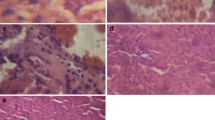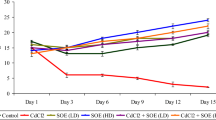Abstract
The present study was undertaken to analyze the antioxidant (both enzymic and nonenzymic) activities of leaves of Ocimum sanctum hydroalcoholic extract against cadmium induced damage in albino rats. Oral administration of cadmium as CdCl2 (6.0 mg/kg body weight) led to significant elevation of lipid peroxidation (LPO) levels and significantly decreased Superoxide Dismutase (SOD), Catalase (CAT), Glutathione Peroxidase (GPx), Reduced Glutathione (GSH) and Vitamin C (Ascorbate) levels. Administration of Ocimum sanctum extract (100 mg/kg body weight, po) and (200 mg/kg body weight, po) before and after cadmium intoxication showed a significant decrease in LPO levels and significant increase in SOD, CAT, GPx, GSH and Ascorbate levels. The results suggest that oral administration of Ocimum sanctum extract provides significant protection against cadmium induced toxicity in Wistar albino rats.
Similar content being viewed by others
References
Swiergosz R, Zaurzewska M, Sawicka-Kapusta K, Bacia K, Jankowska I. Accumulation of cadmium and its effect on bank vole tissues after chronic exposure. Ecotoxicol Environ Saf. 1998;41:130–6.
Stohs SJ, Bagachi D, Hassoun E, Baguchi M. Oxidative mechanisms in the toxicity of chromium and cadmium ions. J Environ Pathol Toxicol Oncol. 2000;19:201–13.
Del Raso NJ, Foy BD, Gerhart JM, Frazier JM. Cadmium uptake kinetics in rat hepatocytes correction for albumin binding. Toxicol Sci. 2003;72:19–30.
Williams F, Robertson R, Roworth M. Detailed profile of 25 major organic and inorganic substances. Glasgow: SCEIH; 1999. pp. 12–19.
Habeebu SS, Liu J, Klaassen CD. Cadmium induced apoptosis in mouse liver. Toxicol Appl Pharmacol. 1998;149(2):203–9.
Chin TA, Templenton DM. Protective elevations of glutathione and metallothionein in cadmium-exposed mesangial cells. Toxicology. 1993;77:145–56.
Zikic RV, Stajn A, Ognjanovic B, Saicic ZS, Kostic MM, Paviovic SZ, Petrovic VM. The effect of cadmium and selenium on the antioxidant enzyme activities in rat heart. J Environ Pathol Toxicol Oncol. 1998;17:259–64.
Fariss MW. Cadmium toxicity: unique cytoprotective properties of alpha-tocopheryl succinate in hepatocytes. Toxicology. 1991;69:63–77.
Lee SE, Ju EM, Kim JH. Free radical scavenging and antioxidant enzyme fortifying activities of extracts from Smilax china root. Exp Mol Med. 2001;33(4):263–8.
Hannan JMA, Marenah L, Ali L, Rokeya B, Flatt PR, Abdel-wahab YHA. Ocimum sanctum leaf extracts stimulate insulin secretion from perfused pancreas, isolated islets and clonal pancreatic β-cells. J Endocrinol. 2006;189:127–36.
Sharma MK, Kumar M, Kumar A. Ocimum sanctum aqueous leaf extract provides protection against mercury induced toxicity in Swiss albino mice. Ind J Exp Biol. 2002;40:1079–82.
Ubaid FS, Anantrao KM, Jaju JB, Mateenuddin MD. Effect of Ocimum sanctum leaf extract on hepatotoxicity induced by antitubercular drugs in rats. Ind J Phy Pharm. 2002;47(4):465–70.
Singh V, Singh A, Nath R, Mishra N, Dixit KS, Singh N. Effect of some anti-stress plant drugs on the intestinal transit. J Biol Chem Res. 1991;10(4):601–2.
Bhargava KP, Singh N. Anti-stress activity of O. sanctum. Ind J MedRes. 1981;73:443–51.
Singh N, Mishra N, Srivastava AK. Effect of antistress plants on biochemical changes during stress reactions. Ind J Pharmacol. 1991;23:137–42.
Singh N, Verma P, Mishra N. A Comparitive evaluation of some antistress agents of plant origin. Ind J Pharmacol. 1991;23:99–103.
Panda S, Kar A. Ocimum sanctum leaf extract in the regulation of thyroid function in the lame mouse. Pharmacol Res. 1998;38(2):107–10.
Balanehru S, Nagarajan B. Intervention of adriamycin induced free radical damage by ursolic acid. Biochem Int. 1992;28:735.
Rajkumar DV, Rao MNA. Dehydrozingerone and isoeugenol as inhibitors of lipid peroxidation and as free radical scavengers. Biochem Pharmacol. 1993;46:2067.
Kokate CK. Preliminary phytochemical screening. In: Practical pharmacognosy, IV ed. New Delhi: Vallabh Prakashan; 2002. p. 107–11.
Jeyaprakash K, Chinnaswamy P. Effect of Spirulina and Liv 52 on cadmium induced toxicity in Albino rats. Ind J Exp Biol. 2005;43:773–81.
Kath RK, Gupta RK. Antioxidant activity of Hydroalcoholic leaf extract of Ocimum sanctum in animal models of peptic ulcer. Indian J Physiol Pharmacol. 2006;50(4):391–6.
Niehius WG, Samuelsson D. Formation of malondialdehyde from phospholipids arachidonate during microsomal lipid peroxidation. Eur J Biochem. 1968;6:126–30.
Kakkar P, Das B, Viswanathan PN. A modified spectrophotometric assay of superoxide dismutase. Ind J Biochem Biophys. 1984;21:130–2.
Sinha AK. Colorimetric assay of catalase. Anal Biochem. 1972;47:389–94.
Rotruck JT, Pope AL, Genther H, Hafeman DG, Hoeckstra WG. Selenium: biochemical role as a component of glutathione peroxidase. Science. 1973;179:588–90.
Moron MJ, Depierre JW, Mannirvik B. Levels of GSH, GR and GST activities in rat lungs and liver. Biochem Biophys Acta. 1979;582:67.
Roe JH, Kuether CA. The determination of ascorbic acid in whole blood and urine through the 2,4-dinitrophenyl hydrazine derivative of dehydro ascorbic acid. J Biol Chem. 1943;147:399–407.
El-Seedi HR, Nishiyama S. Chemistry of bioflavonoids. Ind J Pharm Educ. 2002;36:191–4.
Hsu C-Y. Antioxidant activity of extract from Polygonum aviculare L. Biol Res. 2006;39:281–8.
Rice-Evans CA, Miller NJ, Paganga G. Structure-antioxidant activity relationships of flavonoids and phenolic acids. Free Radical Biol Med. 1996;20:933–56.
Dash DK, Yeligar VC, Nayak SS, Ghosh T, Rajalingam D, Sengupta P, Maity BC, Maity TK. Evaluation of hepatoprotective and antioxidant activity of Ichnocarpus frutescens (Linn) R.Br. on paracetamol-induced hepatotoxicity in rats. Trop J Pharm Res. 2007;6(3):755–65.
Bem EM, Piotrowski JK, Sobczak-Kozlowska M, Dmuchowski C. Cadmium, zinc, copper and metallothionein levels in human liver. Int Arch Occup Environ Health. 1988;60(6):413.
Tang W, Sadovic S, Saikh ZA. Nephrotoxicity of cadmium-metallothionein protection by zinc and role of Glutathione. Toxicol Appli Pharmacol. 1988;151:276.
Gasiewicz TA, Smith JC. Interaction of cadmium and selenium in rat plasma in vivo and in vitro. Biochem Biophys Acta. 1978;428:113.
Suja V, Sharmila SL, Shyamala Devi C. Protective effect of Liv.52 and Liv.100 ayurvedic formulation on lipid peroxidation in rat liver homogenate as in vitro study. Ind J Exp Biol. 1997;35(1):50.
Larson RA. The antioxidants of higher plants. Phytochemistry. 1988;27:969.
Lakshmi Devi S, Kannappan S, Anuradha CV. Evaluation of invitro antioxidant activity of Indian bay leaf, Cinnamomum tamala (Buch-Ham.) T.Nees and Ebrum using rat brain synaptosomes as model system. Ind J Exp Biol. 2007;45:778–84.
Sethi J, Sood S, Seth S, Talwar A. Evaluation of hypoglycemic and antioxidant effect of Ocimum sanctum. Ind J Clin Biochem. 2004;19(2):152–5.
Ognjanovic BI, Pavlovic SZ, Maleti SD, Zikic AS, Stajn ZS, Radojicic RM, Saicic ZS, Petrovic VM. Protective influence of Vitamin E on antioxidant defense system in the blood of rats treated with cadmium. Physiol Res. 2003;52:563–70.
Acknowledgments
The authors are thankful to the management of PSG College of Arts & Science for providing laboratory facilities to carryout this research work.
Author information
Authors and Affiliations
Corresponding author
Rights and permissions
About this article
Cite this article
Ramesh, B., Satakopan, V.N. Antioxidant Activities of Hydroalcoholic Extract of Ocimum sanctum Against Cadmium Induced Toxicity in Rats. Indian J Clin Biochem 25, 307–310 (2010). https://doi.org/10.1007/s12291-010-0039-5
Received:
Accepted:
Published:
Issue Date:
DOI: https://doi.org/10.1007/s12291-010-0039-5




